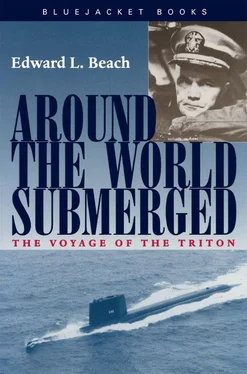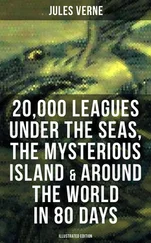Upon initial observation of our own sonar, it was not possible to tell whether the contact we had picked up was on the surface or submerged. Our plot was busy with it, and there was no question that it had movement of its own. It was not bottom effect, that was clear, nor a sharp submerged peak. It was something moving in the water.
I directed the Officer of the Deck to slow down to minimum speed for a sonar investigation. Then, in a few minutes, following standard sonar investigation techniques, we turned Triton’ s head around to the north. After a few more minutes of careful checking, it was evident that we had a real contact. The question was, what was it?
It could be a surface ship cruising about, but it was not maintaining a steady course or speed, a fact suggesting that it was not a merchant ship. It might be a vessel of the Argentine Navy, perhaps one of the ASW ships searching offshore. If this were so, her Captain’s probable state of mind was not apt to be relaxed. We certainly did not wish to create another international incident or, worse, have a depth charge or two tossed toward us by some nervous skipper who might not stop to consider that a submarine submerged three hundred miles at sea is not the same thing as an unknown submarine in your inland waters. Triton should be able to evade Argentina’s best ASW ship, but even so, I could well imagine the reports that might reach the US Navy Department and the questions that I would inevitably have to answer.
A second possibility was that this was another submarine. If this were true, it would almost certainly be confirmation of the submarine contacts in Golfo Nuevo. In that case, the matter would be of importance to the US Navy also, and we should probably find it necessary to send a message stating the situation.
A third possibility, one which submariners and ASW people have long since learned to be alert for, was that our contact was not a man-made vessel at all, but a school of fish. Large fish generally separate into several distinct contacts at some moderate range. A number of small fish moving about as a group can sometimes fool the most experienced sonarman.
At about 0300, Triton’ s periscope broke surface for a cautious search around the horizon, followed by a radar search. Results of both were negative. There was no surface ship around. Back into the depths we went. It was either a submarine or fish. If the former, circumspection was indicated. Slowly and cautiously approaching the contact, we slowly relaxed, for the contact lost its sharp decisive contours, began to fade, and developed wavy outlines. Finally it broke into two parts, and we set Triton once more on the way to Cape Horn. No doubt the school of fish we had so gingerly approached was heartily glad this huge intruder was not hungry.
Some fishermen might have given a lot to have had Triton’ s sonar at this point, for shortly after four o’clock that same morning we detected a second school of fish. Since the characteristics were identical, this time there was less difficulty in making a positive identification, and we were quickly rewarded by seeing the contact break up into numerous smaller blips.
Poole’s condition was getting steadily worse, Jim Stark told me, yet there was nothing he could do for him but wait and see. Poole’s senses, at least, were dulled by the morphine.
After seeing the patient at about five o’clock in the morning, my recollection is that I finally was able to get a little sleep. Upon awakening, I was astonished to find Poole dressed and once again on his feet in the radar department. As before, Jim Stark just happened to be only a few feet away, ostensibly looking over some of his medical supplies in the pharmacy. Jim could not be sure that the second stone had safely passed.
The only other event of this day was the receipt of our second babygram, for Chief Electrician James DeGange. Another girl, born March 1, 1960; the message from Admiral Daspit gave the further information that mother and Patricia Ann were both doing well.
The third of March began propitiously. We were still watching Poole carefully, but all looked well for the time being. He had been free of pain for some eighteen hours. Our course for Cape Horn had been laid out to bring us close to the Falkland Islands and permit us to run near Port Stanley, their biggest harbor. For drill purposes, we intended to make a photo reconnaissance; that is, take a series of photographs through our periscope. This was a technique submarines had developed during the war, by which important information was brought back to our Marine and Army landing forces.
The Falkland Islands are famous for the naval battle which took place there on the eighth of December, 1914. A month earlier, on November first, a strong German squadron of cruisers under Admiral von Spee had overwhelmed a weaker British squadron under Admiral Cradock off the cape of Coronel on the coast of Chile. The two biggest British ships, including the flagship, were sunk with all hands. Then Von Spee headed for Cape Horn at a leisurely pace, intending to capture the coaling station at the Falkland Islands, refuel, and head back to Germany. His big mistake was in moving so slowly, for when the English heard of the defeat of Cradock, they sent two of their battle cruisers, under Admiral Sturdee, from England direct to the Falkland Islands, with orders to coal at Port Stanley and then search out Von Spee. It was the ideal mission for a versatile British Navy and its new battle cruisers, as they were fast heavily armed ships which far outclassed Von Spee’s armored cruisers in both speed and gunpower.
After a high-speed run the length of the Atlantic, Sturdee reached the Falkland Islands the day before Von Spee showed up. Von Spee’s second mistake was in making his appearance at about eight o’clock in the morning, with a long summer day ahead of him. The Inflexible and the Invincible were coaling at Port Stanley when the German cruisers appeared on the horizon. Hastily casting off, Sturdee set out in pursuit. When Von Spee realized that the two big ships sortieing from Port Stanley were battle cruisers with twelve-inch guns, he turned and tried to escape. This might be termed his third mistake, for, with a fight inevitable, he should have got his own shorter-range guns into action while he could. Once lost, the opportunity never returned. Inexorably, the British overhauled him sufficiently to open fire—and then, when necessary, used their superior speed to stay out of range of Von Spee’s guns.
One of the stories of that battle is that an old sailing ship which happened to be in the area suddenly found herself directly in the line of fire. Great ripping sounds were heard as the armor-piercing shells whistled overhead, but the extreme range of the British caused all the shells to pass harmlessly thousands of feet above her.
Von Spee’s two bigger ships were the Scharnhorst and Gneisenau, both of which had held the Fleet Gunnery Trophy in the German Navy and were known as crack ships. But now the tables were turned, and in a few hours Von Spee, with his two fine cruisers, joined Cradock and his Good Hope and Monmouth at the bottom of the sea.
Scharnhorst and Gneisenau went down fighting; there were no survivors. They had not been able to inflict any damage of any kind on the British ships, any more than Cradock had been able to hurt Von Spee in the first encounter. But there was established a proud tradition in the German Navy, commemorated in World War II by some more recently remembered names of men-of-war.
According to Will Adams, we should sight the Falkland Islands at about ten o’clock in the morning. A little before this we came to periscope depth, put up the radar, and there, precisely as predicted, was a “pip” on the radar scope obviously made by land. The photographic reconnaissance party under Dick Harris, with cameras and equipment, was standing by in the conning tower ready for the initial approach, when Jim Stark sought me out. His face was like a thundercloud.
Читать дальше












